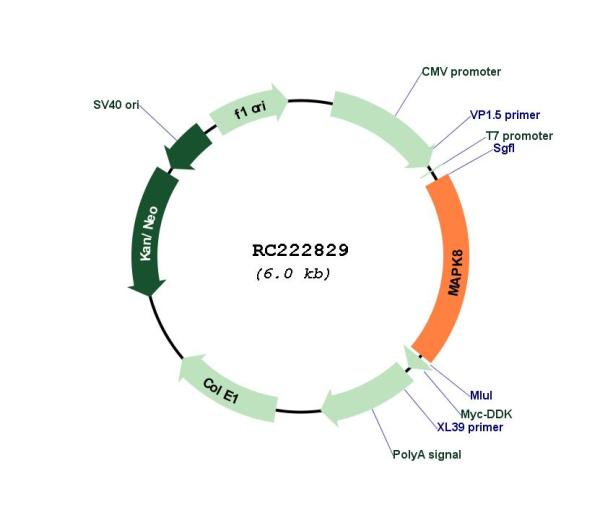JNK1 (MAPK8) (NM_139046) Human Tagged ORF Clone
CAT#: RC222829
MAPK8 (Myc-DDK-tagged)-Human mitogen-activated protein kinase 8 (MAPK8), transcript variant JNK1-b1
ORF Plasmid: tGFP
Lentiviral Particles: DDK DDK w/ Puro mGFP mGFP w/ Puro
AAV Particle: DDK
"NM_139046" in other vectors (6)
USD 198.00
Specifications
| Product Data | |
| Type | Human Tagged ORF Clone |
| Tag | Myc-DDK |
| Symbol | JNK1 |
| Synonyms | JNK; JNK-46; JNK1; JNK1A2; JNK21B1/2; PRKM8; SAPK1; SAPK1c |
| Vector | pCMV6-Entry |
| E. coli Selection | Kanamycin (25 ug/mL) |
| Mammalian Cell Selection | Neomycin |
| Sequence Data |
>RC222829 representing NM_139046
Red=Cloning site Blue=ORF Green=Tags(s) TTTTGTAATACGACTCACTATAGGGCGGCCGGGAATTCGTCGACTGGATCCGGTACCGAGGAGATCTGCC GCCGCGATCGCC ATGAGCAGAAGCAAGCGTGACAACAATTTTTATAGTGTAGAGATTGGAGATTCTACATTCACAGTCCTGA AACGATATCAGAATTTAAAACCTATAGGCTCAGGAGCTCAAGGAATAGTATGCGCAGCTTATGATGCCAT TCTTGAAAGAAATGTTGCAATCAAGAAGCTAAGCCGACCATTTCAGAATCAGACTCATGCCAAGCGGGCC TACAGAGAGCTAGTTCTTATGAAATGTGTTAATCACAAAAATATAATTGGCCTTTTGAATGTTTTCACAC CACAGAAATCCCTAGAAGAATTTCAAGATGTTTACATAGTCATGGAGCTCATGGATGCAAATCTTTGCCA AGTGATTCAGATGGAGCTAGATCATGAAAGAATGTCCTACCTTCTCTATCAGATGCTGTGTGGAATCAAG CACCTTCATTCTGCTGGAATTATTCATCGGGACTTAAAGCCCAGTAATATAGTAGTAAAATCTGATTGCA CTTTGAAGATTCTTGACTTCGGTCTGGCCAGGACTGCAGGAACGAGTTTTATGATGACGCCTTATGTAGT GACTCGCTACTACAGAGCACCCGAGGTCATCCTTGGCATGGGCTACAAGGAAAACGTTGACATTTGGTCA GTTGGGTGCATCATGGGAGAAATGATCAAAGGTGGTGTTTTGTTCCCAGGTACAGATCATATTGATCAGT GGAATAAAGTTATTGAACAGCTTGGAACACCATGTCCTGAATTCATGAAGAAACTGCAACCAACAGTAAG GACTTACGTTGAAAACAGACCTAAATATGCTGGATATAGCTTTGAGAAACTCTTCCCTGATGTCCTTTTC CCAGCTGACTCAGAACACAACAAACTTAAAGCCAGTCAGGCAAGGGATTTGTTATCCAAAATGCTGGTAA TAGATGCATCTAAAAGGATCTCTGTAGATGAAGCTCTCCAACACCCGTACATCAATGTCTGGTATGATCC TTCTGAAGCAGAAGCTCCACCACCAAAGATCCCTGACAAGCAGTTAGATGAAAGGGAACACACAATAGAA GAGTGGAAAGAATTGATATATAAGGAAGTTATGGACTTGGAGGAGAGAACCAAGAATGGAGTTATACGGG GGCAGCCCTCTCCTTTAGCACAGGTGCAGCAG ACGCGTACGCGGCCGCTCGAGCAGAAACTCATCTCAGAAGAGGATCTGGCAGCAAATGATATCCTGGATT ACAAGGATGACGACGATAAGGTTTAA >RC222829 representing NM_139046
Red=Cloning site Green=Tags(s) MSRSKRDNNFYSVEIGDSTFTVLKRYQNLKPIGSGAQGIVCAAYDAILERNVAIKKLSRPFQNQTHAKRA YRELVLMKCVNHKNIIGLLNVFTPQKSLEEFQDVYIVMELMDANLCQVIQMELDHERMSYLLYQMLCGIK HLHSAGIIHRDLKPSNIVVKSDCTLKILDFGLARTAGTSFMMTPYVVTRYYRAPEVILGMGYKENVDIWS VGCIMGEMIKGGVLFPGTDHIDQWNKVIEQLGTPCPEFMKKLQPTVRTYVENRPKYAGYSFEKLFPDVLF PADSEHNKLKASQARDLLSKMLVIDASKRISVDEALQHPYINVWYDPSEAEAPPPKIPDKQLDEREHTIE EWKELIYKEVMDLEERTKNGVIRGQPSPLAQVQQ TRTRPLEQKLISEEDLAANDILDYKDDDDKV |
| Chromatograms |
CHROMATOGRAMS
 Sequencher program is needed, download here. |
| Restriction Sites |
SgfI-MluI
Cloning Scheme for this gene
Plasmid Map

|
| ACCN | NM_139046 |
| ORF Size | 1152 bp |
| OTI Disclaimer | The molecular sequence of this clone aligns with the gene accession number as a point of reference only. However, individual transcript sequences of the same gene can differ through naturally occurring variations (e.g. polymorphisms), each with its own valid existence. This clone is substantially in agreement with the reference, but a complete review of all prevailing variants is recommended prior to use. More info |
| OTI Annotation | This clone was engineered to express the complete ORF with an expression tag. Expression varies depending on the nature of the gene. |
| Product Components | The ORF clone is ion-exchange column purified and shipped in a 2D barcoded Matrix tube containing 10ug of transfection-ready, dried plasmid DNA (reconstitute with 100 ul of water). |
| Reconstitution | 1. Centrifuge at 5,000xg for 5min. 2. Carefully open the tube and add 100ul of sterile water to dissolve the DNA. 3. Close the tube and incubate for 10 minutes at room temperature. 4. Briefly vortex the tube and then do a quick spin (less than 5000xg) to concentrate the liquid at the bottom. 5. Store the suspended plasmid at -20°C. The DNA is stable for at least one year from date of shipping when stored at -20°C. |
| Reference Data | |
| RefSeq | NM_139046.4 |
| RefSeq Size | 1417 bp |
| RefSeq ORF | 1155 bp |
| Locus ID | 5599 |
| UniProt ID | P45983 |
| Cytogenetics | 10q11.22 |
| Protein Families | Druggable Genome, ES Cell Differentiation/IPS, Protein Kinase |
| Protein Pathways | Adipocytokine signaling pathway, Colorectal cancer, Epithelial cell signaling in Helicobacter pylori infection, ErbB signaling pathway, Fc epsilon RI signaling pathway, Focal adhesion, GnRH signaling pathway, Insulin signaling pathway, MAPK signaling pathway, Neurotrophin signaling pathway, NOD-like receptor signaling pathway, Pancreatic cancer, Pathways in cancer, Progesterone-mediated oocyte maturation, RIG-I-like receptor signaling pathway, Toll-like receptor signaling pathway, Type II diabetes mellitus, Wnt signaling pathway |
| MW | 43.8 kDa |
| Gene Summary | The protein encoded by this gene is a member of the MAP kinase family. MAP kinases act as an integration point for multiple biochemical signals, and are involved in a wide variety of cellular processes such as proliferation, differentiation, transcription regulation and development. This kinase is activated by various cell stimuli, and targets specific transcription factors, and thus mediates immediate-early gene expression in response to cell stimuli. The activation of this kinase by tumor-necrosis factor alpha (TNF-alpha) is found to be required for TNF-alpha induced apoptosis. This kinase is also involved in UV radiation induced apoptosis, which is thought to be related to cytochrom c-mediated cell death pathway. Studies of the mouse counterpart of this gene suggested that this kinase play a key role in T cell proliferation, apoptosis and differentiation. Several alternatively spliced transcript variants encoding distinct isoforms have been reported. [provided by RefSeq, Apr 2016] |
Documents
| Product Manuals |
| FAQs |
| SDS |
Resources
Other Versions
| SKU | Description | Size | Price |
|---|---|---|---|
| RC222829L1 | Lenti ORF clone of Human mitogen-activated protein kinase 8 (MAPK8), transcript variant JNK1-b1, Myc-DDK-tagged |
USD 757.00 |
|
| RC222829L2 | Lenti ORF clone of Human mitogen-activated protein kinase 8 (MAPK8), transcript variant JNK1-b1, mGFP tagged |
USD 757.00 |
|
| RC222829L3 | Lenti ORF clone of Human mitogen-activated protein kinase 8 (MAPK8), transcript variant JNK1-b1, Myc-DDK-tagged |
USD 757.00 |
|
| RC222829L4 | Lenti ORF clone of Human mitogen-activated protein kinase 8 (MAPK8), transcript variant JNK1-b1, mGFP tagged |
USD 757.00 |
|
| RG222829 | MAPK8 (tGFP-tagged) - Human mitogen-activated protein kinase 8 (MAPK8), transcript variant JNK1-b1 |
USD 657.00 |
|
| SC124375 | MAPK8 (untagged)-Human mitogen-activated protein kinase 8 (MAPK8), transcript variant JNK1-b1 |
USD 457.00 |
{0} Product Review(s)
Be the first one to submit a review






























































































































































































































































 Germany
Germany
 Japan
Japan
 United Kingdom
United Kingdom
 China
China





